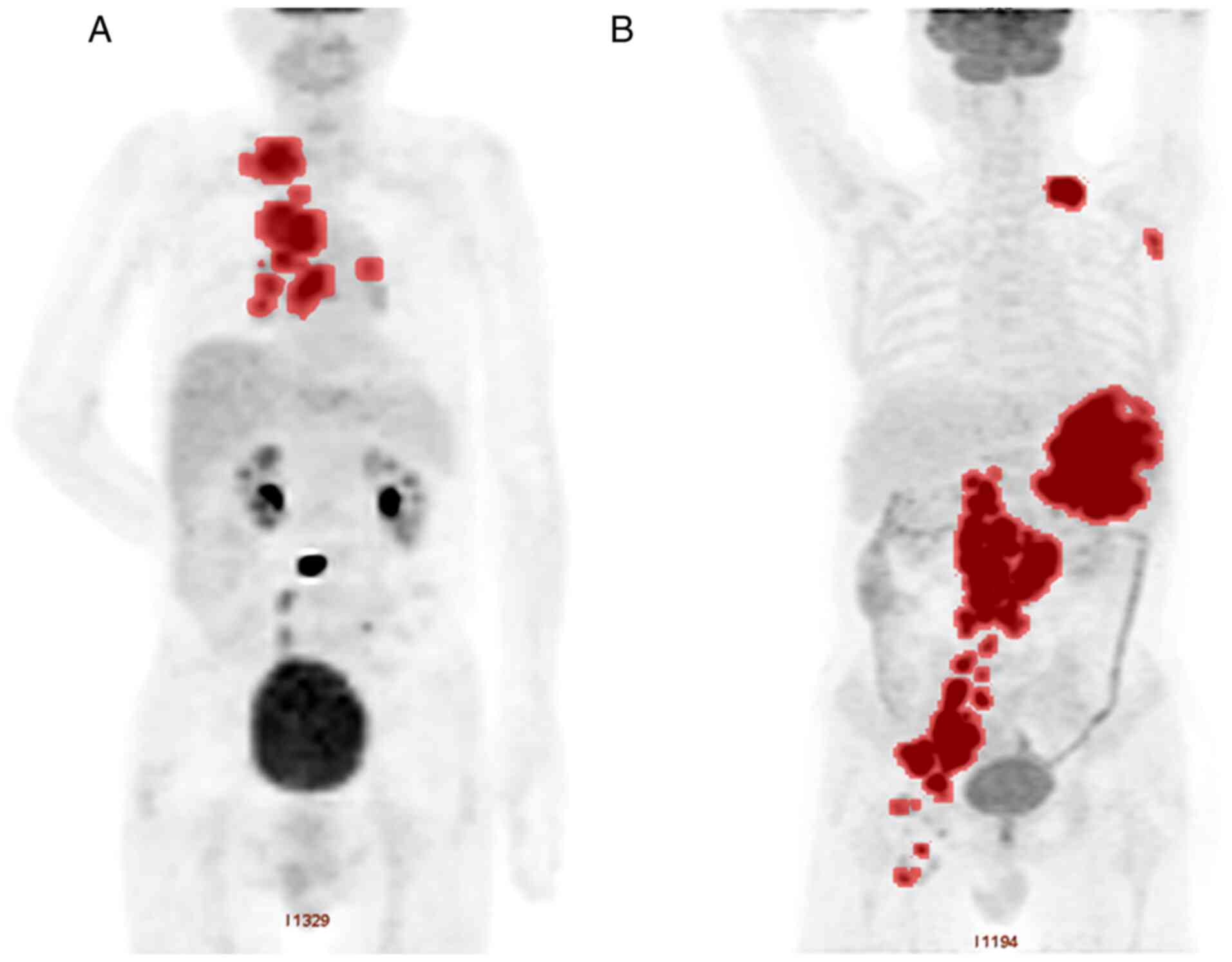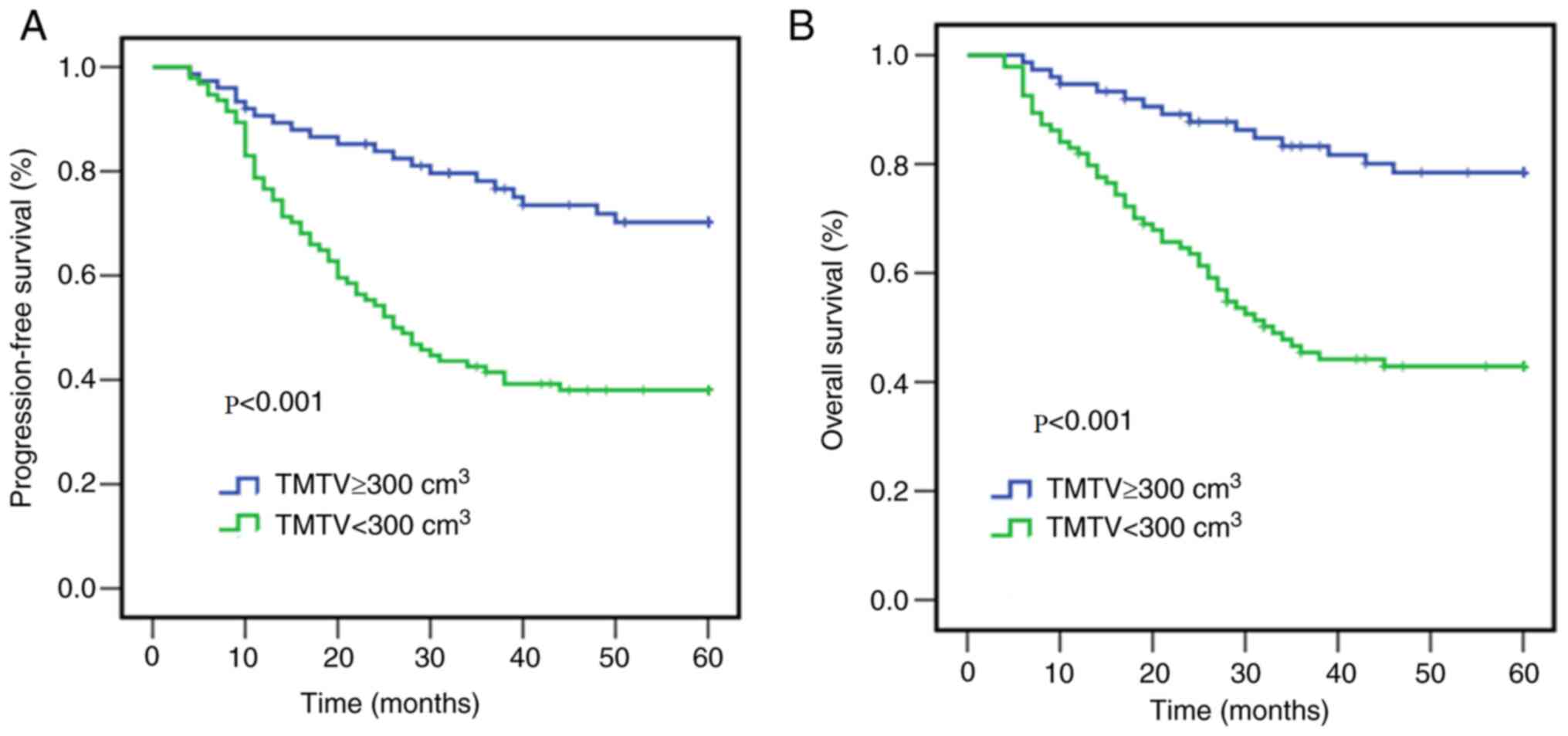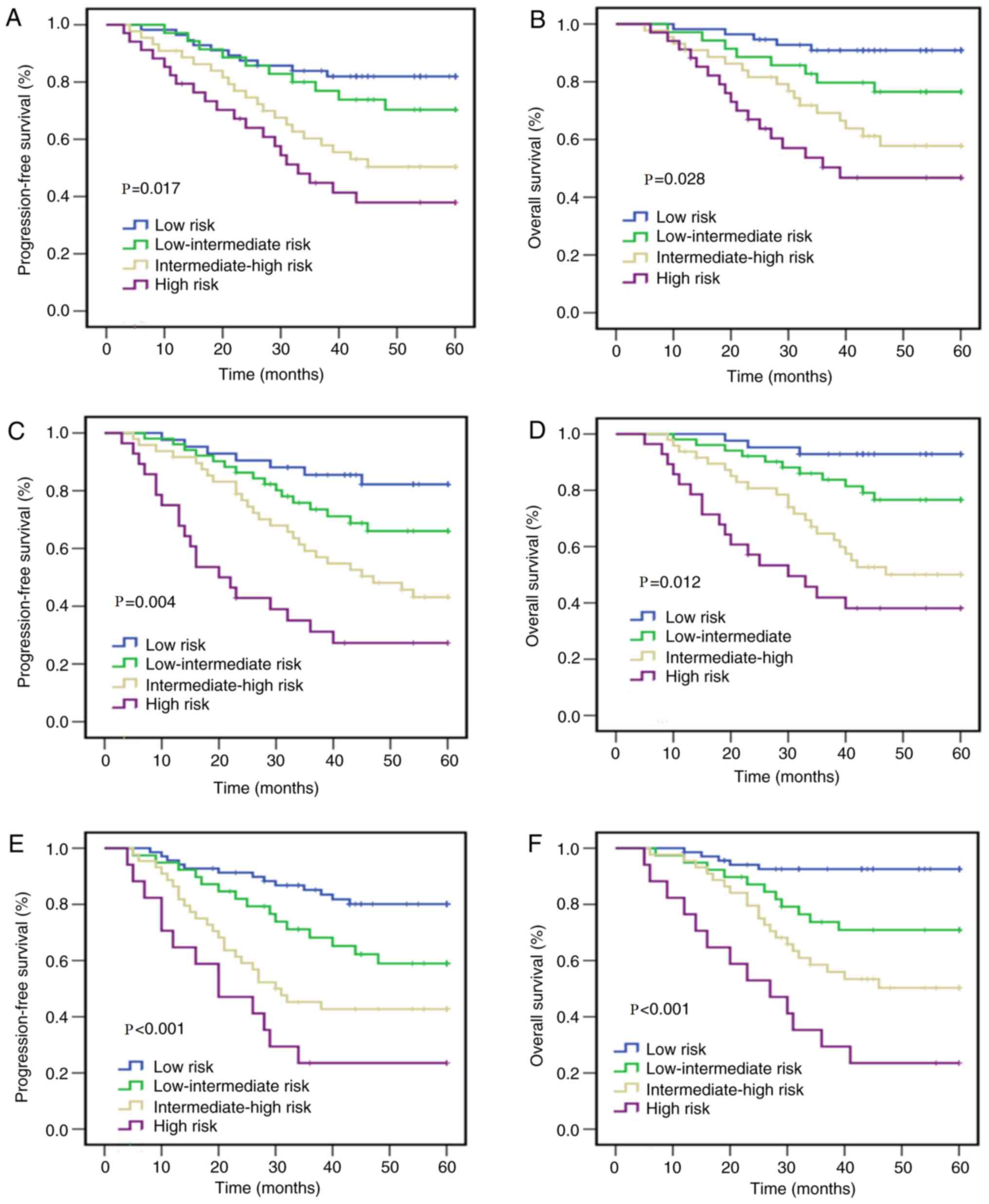|
1
|
Jaffe ES: The 2008 WHO classification of
lymphomas: Implications for clinical practice and translational
research. Hematology Am Soc Hematol Educ Program. 523–531. 2009.
View Article : Google Scholar : PubMed/NCBI
|
|
2
|
Sehn LH and Gascoyne RD: Diffuse large
B-cell lymphoma: Optimizing outcome in the context of clinical and
biologic heterogeneity. Blood. 125:22–32. 2015. View Article : Google Scholar : PubMed/NCBI
|
|
3
|
Chapuy B, Stewart C, Dunford AJ, Kim J,
Kamburov A, Redd RA, Lawrence MS, Roemer MGM, Li AJ, Ziepert M, et
al: Molecular subtypes of diffuse large B cell lymphoma are
associated with distinct pathogenic mechanisms and outcomes. Nat
Med. 24:679–690. 2018. View Article : Google Scholar : PubMed/NCBI
|
|
4
|
Schmitz R, Wright GW, Huang DW, Johnson
CA, Phelan JD, Wang JQ, Roulland S, Kasbekar M, Young RM, Shaffer
AL, et al: Genetics and pathogenesis of diffuse large B-cell
lymphoma. N Engl J Med. 378:1396–1407. 2018. View Article : Google Scholar : PubMed/NCBI
|
|
5
|
Cunningham D, Hawkes EA, Jack A, Qian W,
Smith P, Mouncey P, Pocock C, Ardeshna KM, Radford JA, McMillan A,
et al: Rituximab plus cyclophosphamide, doxorubicin, vincristine,
and prednisolone in patients with newly diagnosed diffuse large
B-cell non-Hodgkin lymphoma: A phase 3 comparison of dose
intensification with 14-day versus 21-day cycles. Lancet.
381:1817–1826. 2013. View Article : Google Scholar : PubMed/NCBI
|
|
6
|
International Non-Hodgkin's Lymphoma
Prognostic Factors Project, . A predictive model for aggressive
non-Hodgkin's lymphoma. N Engl J Med. 329:987–994. 1993. View Article : Google Scholar : PubMed/NCBI
|
|
7
|
Bari A, Marcheselli L, Sacchi S,
Marcheselli R, Pozzi S, Ferri P, Balleari E, Musto P, Neri S, Aloe
Spiriti MA and Cox MC: Prognostic models for diffuse large B-cell
lymphoma in the rituximab era: A never-ending story. Ann Oncol.
21:1486–1491. 2010. View Article : Google Scholar : PubMed/NCBI
|
|
8
|
Ziepert M, Hasenclever D, Kuhnt E, Glass
B, Schmitz N, Pfreundschuh M and Loeffler M: Standard International
prognostic index remains a valid predictor of outcome for patients
with aggressive CD20+ B-cell lymphoma in the rituximab
era. J Clin Oncol. 28:2373–2380. 2010. View Article : Google Scholar : PubMed/NCBI
|
|
9
|
Zhou Z, Sehn LH, Rademaker AW, Gordon LI,
Lacasce AS, Crosby-Thompson A, Vanderplas A, Zelenetz AD, Abel GA,
Rodriguez MA, et al: An enhanced International Prognostic Index
(NCCN-IPI) for patients with diffuse large B-cell lymphoma treated
in the rituximab era. Blood. 123:837–842. 2014. View Article : Google Scholar : PubMed/NCBI
|
|
10
|
Adams HJ and Kwee TC: Prognostic value of
interim FDG-PET in R-CHOP-treated diffuse large B-cell lymphoma:
Systematic review and meta-analysis. Crit Rev Oncol Hematol.
106:55–63. 2016. View Article : Google Scholar : PubMed/NCBI
|
|
11
|
Nakaya A, Fujita S, Satake A, Nakanishi T,
Azuma Y, Tsubokura Y, Hotta M, Yoshimura H, Ishii K, Ito T and
Nomura S: Enhanced international prognostic index in Japanese
patients with diffuse large B-cell lymphoma. Leuk Res Rep. 6:24–26.
2016.PubMed/NCBI
|
|
12
|
Prochazka KT, Melchardt T, Posch F,
Schlick K, Deutsch A, Beham-Schmid C, Weiss L, Gary T, Neureiter D,
Klieser E, et al: NCCN-IPI score-independent prognostic potential
of pretreatment uric acid levels for clinical outcome of diffuse
large B-cell lymphoma patients. Br J Cancer. 115:1264–1272. 2016.
View Article : Google Scholar : PubMed/NCBI
|
|
13
|
Montalbán C, Díaz-López A, Dlouhy I,
Rovira J, Lopez-Guillermo A, Alonso S, Martín A, Sancho JM, García
O, Sánchez JM, et al: Validation of the NCCN-IPI for diffuse large
B-cell lymphoma (DLBCL): The addition of
β2-microglobulin yields a more accurate GELTAMO-IPI. Br
J Haematol. 176:918–928. 2017. View Article : Google Scholar : PubMed/NCBI
|
|
14
|
Dybkaer K, Bøgsted M, Falgreen S, Bødker
JS, Kjeldsen MK, Schmitz A, Bilgrau AE, Xu-Monette ZY, Li L,
Bergkvist KS, et al: Diffuse large B-cell lymphoma classification
system that associates normal B-cell subset phenotypes with
prognosis. J Clin Oncol. 33:1379–1388. 2015. View Article : Google Scholar : PubMed/NCBI
|
|
15
|
Cheson BD, Pfistner B, Juweid ME, Gascoyne
RD, Specht L, Horning SJ, Coiffier B, Fisher RI, Hagenbeek A, Zucca
E, et al: Revised response criteria for malignant lymphoma. J Clin
Oncol. 25:579–586. 2007. View Article : Google Scholar : PubMed/NCBI
|
|
16
|
Schot BW, Zijlstra JM, Sluiter WJ, van
Imhoff GW, Pruim J, Vaalburg W and Vellenga E: Early FDG-PET
assessment in combination with clinical risk scores determines
prognosis in recurring lymphoma. Blood. 109:486–491. 2007.
View Article : Google Scholar : PubMed/NCBI
|
|
17
|
Culpin RE, Sieniawski M, Angus B, Menon
GK, Proctor SJ, Milne P, McCabe K and Mainou-Fowler T: Prognostic
significance of immunohistochemistry-based markers and algorithms
in immunochemotherapy-treated diffuse large B cell lymphoma
patients. Histopathology. 63:788–801. 2013. View Article : Google Scholar : PubMed/NCBI
|
|
18
|
Wight JC, Chong G, Grigg AP and Hawkes EA:
Prognostication of diffuse large B-cell lymphoma in the molecular
era: Moving beyond the IPI. Blood Rev. 32:400–415. 2018. View Article : Google Scholar : PubMed/NCBI
|
|
19
|
Kim J, Hong J, Kim SG, Hwang KH, Kim M,
Ahn HK, Sym SJ, Park J, Cho EK, Shin DB and Lee JH: Prognostic
value of metabolic tumor volume estimated by (18) F-FDG positron
emission tomography/computed tomography in patients with diffuse
large B-cell lymphoma of stage II or III disease. Nucl Med Mol
Imaging. 48:187–195. 2014. View Article : Google Scholar : PubMed/NCBI
|
|
20
|
Sasanelli M, Meignan M, Haioun C,
Berriolo-Riedinger A, Casasnovas RO, Biggi A, Gallamini A, Siegel
BA, Cashen AF, Véra P, et al: Pretherapy metabolic tumour volume is
an independent predictor of outcome in patients with diffuse large
B-cell lymphoma. Eur J Nucl Med Mol Imaging. 41:2017–2022. 2014.
View Article : Google Scholar : PubMed/NCBI
|
|
21
|
Tout M, Casasnovas O, Meignan M, Lamy T,
Morschhauser F, Salles G, Gyan E, Haioun C, Mercier M, Feugier P,
et al: Rituximab exposure is influenced by baseline metabolic tumor
volume and predicts outcome of DLBCL patients: A Lymphoma Study
Association report. Blood. 129:2616–2623. 2017. View Article : Google Scholar : PubMed/NCBI
|
|
22
|
Vitolo U, Trněný M, Belada D, Burke JM,
Carella AM, Chua N, Abrisqueta P, Demeter J, Flinn I, Hong X, et
al: Obinutuzumab or rituximab plus cyclophosphamide, doxorubicin,
vincristine, and prednisone in previously untreated diffuse large
B-cell lymphoma. J Clin Oncol. 35:3529–3537. 2017. View Article : Google Scholar : PubMed/NCBI
|
|
23
|
Hans CP, Weisenburger DD, Greiner TC,
Gascoyne RD, Delabie J, Ott G, Müller-Hermelink HK, Campo E,
Braziel RM, Jaffe ES, et al: Confirmation of the molecular
classification of diffuse large B-cell lymphoma by
immunohistochemistry using a tissue microarray. Blood. 103:275–282.
2004. View Article : Google Scholar : PubMed/NCBI
|
|
24
|
Cheson BD, Fisher RI, Barrington SF,
Cavalli F, Schwartz LH, Zucca E, Lister TA; Alliance, Australasian
Leukaemia and Lymphoma Group; Eastern Cooperative Oncology Group;
European Mantle Cell Lymphoma Consortium, ; et al: Recommendations
for initial evaluation, staging, and response assessment of Hodgkin
and non-Hodgkin lymphoma: The Lugano classification. J Clin Oncol.
32:3059–3068. 2014. View Article : Google Scholar : PubMed/NCBI
|
|
25
|
Zhu L, Bian H, Yang L, Liu J, Chen W, Li
X, Wang J, Song X, Dai D, Ye Z, et al:
18Fluorodeoxyglucose-positron emission
tomography/computed tomography features of suspected solitary
pulmonary lesions in breast cancer patients following previous
curative treatment. Thorac Cancer. 10:1086–1095. 2019. View Article : Google Scholar : PubMed/NCBI
|
|
26
|
Zhao P, Li L, Zhou S, Qiu L, Qian Z, Liu
X, Meng B and Zhang H: CD5 expression correlates with inferior
survival and enhances the negative effect of p53 overexpression in
diffuse large B-cell lymphoma. Hematol Oncol. 37:360–367. 2019.
View Article : Google Scholar : PubMed/NCBI
|
|
27
|
Sehn LH, Berry B, Chhanabhai M, Fitzgerald
C, Gill K, Hoskins P, Klasa R, Savage KJ, Shenkier T, Sutherland J,
et al: The revised International Prognostic Index (R-IPI) is a
better predictor of outcome than the standard IPI for patients with
diffuse large B-cell lymphoma treated with R-CHOP. Blood.
109:1857–1861. 2007. View Article : Google Scholar : PubMed/NCBI
|
|
28
|
McMillan DC: Systemic inflammation,
nutritional status and survival in patients with cancer. Curr Opin
Clin Nutr Metab Care. 12:223–226. 2009. View Article : Google Scholar : PubMed/NCBI
|
|
29
|
Li X, Zhang Y, Zhao W, Liu Z, Shen Y, Li J
and Shen Z: The Glasgow Prognostic Score as a significant predictor
of diffuse large B cell lymphoma treated with R-CHOP in China. Ann
Hematol. 94:57–63. 2015. View Article : Google Scholar : PubMed/NCBI
|
|
30
|
Dreyling M, Campo E, Hermine O, Jerkeman
M, Le Gouill S, Rule S, Shpilberg O, Walewski J and Ladetto M; ESMO
Guidelines Committee, : Newly diagnosed and relapsed mantle cell
lymphoma: ESMO Clinical Practice Guidelines for diagnosis,
treatment and follow-up. Ann Oncol. 28 (Suppl 4):iv62–iv71. 2017.
View Article : Google Scholar : PubMed/NCBI
|
|
31
|
El-Galaly TC, Villa D, Gormsen LC, Baech
J, Lo A and Cheah CY: FDG-PET/CT in the management of lymphomas:
Current status and future directions. J Intern Med. 284:358–376.
2018. View Article : Google Scholar : PubMed/NCBI
|
|
32
|
Sun H, Yu Z, Ma N, Zhou J, Tian R, Zhao M
and Wang T: Risk stratification of diffuse large B-cell lymphoma
with interim PET/CT by combining deauville scores and international
prognostic index. Cancer Manag Res. 11:9449–9457. 2019. View Article : Google Scholar : PubMed/NCBI
|
|
33
|
Yim SK, Yhim HY, Han YH, Jeon SY, Lee NR,
Song EK, Jeong HJ, Kim HS and Kwak JY: Early risk stratification
for diffuse large B-cell lymphoma integrating interim Deauville
score and International Prognostic Index. Ann Hematol.
98:2739–2748. 2019. View Article : Google Scholar : PubMed/NCBI
|
|
34
|
Kostakoglu L and Chauvie S: Metabolic
tumor volume metrics in lymphoma. Semin Nucl Med. 48:50–66. 2018.
View Article : Google Scholar : PubMed/NCBI
|
|
35
|
Akamatsu G, Ikari Y, Nishida H, Nishio T,
Ohnishi A, Maebatake A, Sasaki M and Senda M: Influence of
statistical fluctuation on reproducibility and accuracy of SUVmax
and SUVpeak: A Phantom Study. J Nucl Med Technol. 43:222–226. 2015.
View Article : Google Scholar : PubMed/NCBI
|
|
36
|
Park S, Moon SH, Park LC, Hwang DW, Ji JH,
Maeng CH, Cho SH, Ahn HK, Lee JY, Kim SJ, et al: The impact of
baseline and interim PET/CT parameters on clinical outcome in
patients with diffuse large B cell lymphoma. Am J Hematol.
87:937–940. 2012. View Article : Google Scholar : PubMed/NCBI
|
|
37
|
Gallicchio R, Mansueto G, Simeon V,
Nardelli A, Guariglia R, Capacchione D, Soscia E, Pedicini P,
Gattozzi D, Musto P and Storto G: F-18 FDG PET/CT quantization
parameters as predictors of outcome in patients with diffuse large
B-cell lymphoma. Eur J Haematol. 92:382–389. 2014. View Article : Google Scholar : PubMed/NCBI
|
|
38
|
Kim TM, Paeng JC, Chun IK, Keam B, Jeon
YK, Lee SH, Kim DW, Lee DS, Kim CW, Chung JK, et al: Total lesion
glycolysis in positron emission tomography is a better predictor of
outcome than the International Prognostic Index for patients with
diffuse large B cell lymphoma. Cancer. 119:1195–1202. 2013.
View Article : Google Scholar : PubMed/NCBI
|
|
39
|
Zhao P, Zhu L, Song Z, Wang X, Ma W, Zhu
X, Qiu L, Li L, Zhou S, Qian Z, et al: Combination of baseline
total metabolic tumor volume measured on FDG-PET/CT and
β2-microglobulin have a robust predictive value in patients with
primary breast lymphoma. Hematol Oncol. 38:493–500. 2020.
View Article : Google Scholar : PubMed/NCBI
|
|
40
|
Cottereau AS, Lanic H, Mareschal S,
Meignan M, Vera P, Tilly H, Jardin F and Becker S: Molecular
profile and FDG-PET/CT total metabolic tumor volume improve risk
classification at diagnosis for patients with diffuse large B-cell
lymphoma. Clin Cancer Res. 22:3801–3809. 2016. View Article : Google Scholar : PubMed/NCBI
|
|
41
|
Mikhaeel NG, Smith D, Dunn JT, Phillips M,
Møller H, Fields PA, Wrench D and Barrington SF: Combination of
baseline metabolic tumour volume and early response on PET/CT
improves progression-free survival prediction in DLBCL. Eur J Nucl
Med Mol Imaging. 43:1209–1219. 2016. View Article : Google Scholar : PubMed/NCBI
|
|
42
|
Song MK, Chung JS, Shin HJ, Lee SM, Lee
SE, Lee HS, Lee GW, Kim SJ, Lee SM and Chung DS: Clinical
significance of metabolic tumor volume by PET/CT in stages II and
III of diffuse large B cell lymphoma without extranodal site
involvement. Ann Hematol. 91:697–703. 2012. View Article : Google Scholar : PubMed/NCBI
|
|
43
|
Xie M, Zhai W, Cheng S, Zhang H, Xie Y and
He W: Predictive value of F-18 FDG PET/CT quantization parameters
for progression-free survival in patients with diffuse large B-cell
lymphoma. Hematology. 21:99–105. 2016. View Article : Google Scholar : PubMed/NCBI
|
|
44
|
Meignan M, Sasanelli M, Casasnovas RO,
Luminari S, Fioroni F, Coriani C, Masset H, Itti E, Gobbi PG, Merli
F and Versari A: Metabolic tumour volumes measured at staging in
lymphoma: Methodological evaluation on phantom experiments and
patients. Eur J Nucl Med Mol Imaging. 41:1113–1122. 2014.
View Article : Google Scholar : PubMed/NCBI
|
|
45
|
Ilyas H, Mikhaeel NG, Dunn JT, Rahman F,
Møller H, Smith D and Barrington SF: Defining the optimal method
for measuring baseline metabolic tumour volume in diffuse large B
cell lymphoma. Eur J Nucl Med Mol Imaging. 45:1142–1154. 2018.
View Article : Google Scholar : PubMed/NCBI
|
|
46
|
Gulec SA, Suthar RR, Barot TC and
Pennington K: The prognostic value of functional tumor volume and
total lesion glycolysis in patients with colorectal cancer liver
metastases undergoing 90Y selective internal radiation therapy plus
chemotherapy. Eur J Nucl Med Mol Imaging. 38:1289–1295. 2011.
View Article : Google Scholar : PubMed/NCBI
|
|
47
|
Yang DH, Ahn JS, Byun BH, Min JJ, Kweon
SS, Chae YS, Sohn SK, Lee SW, Kim HW, Jung SH, et al: Interim
PET/CT-based prognostic model for the treatment of diffuse large B
cell lymphoma in the post-rituximab era. Ann Hematol. 92:471–479.
2013. View Article : Google Scholar : PubMed/NCBI
|
|
48
|
Zhang YY, Song L, Zhao MX and Hu K: A
better prediction of progression-free survival in diffuse large
B-cell lymphoma by a prognostic model consisting of baseline TLG
and % ∆SUVmax. Cancer Med. 8:5137–147. 2019. View Article : Google Scholar : PubMed/NCBI
|
|
49
|
Friedberg JW and Fisher RI: Diffuse large
B-cell lymphoma. Hematol Oncol Clin North Am. 22941–952. (ix)2008.
View Article : Google Scholar : PubMed/NCBI
|

















